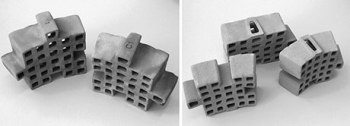Jul 29 2014
Using 3-D printing and advanced geometry, a team at Cornell has developed a new kind of building material – interlocking ceramic bricks that are lightweight, need no mortar and make efficient use of materials.
 PolyBricks are created on a 3-D printer as greenware, at left, and then fired. The ceramic bricks after one firing are shown at right. Credit: Provided
PolyBricks are created on a 3-D printer as greenware, at left, and then fired. The ceramic bricks after one firing are shown at right. Credit: Provided
Developed by the Sabin Design Lab in collaboration with Cornell and Jenny Sabin Studio, the PolyBrick project team included assistant professor of architecture Jenny Sabin with senior research associate Martin Miller, a visiting critic at Cornell; visiting lecturer Andrew Lucia; and Nicholas Cassab, B.Arch. ’14.
“PolyBrick is the first mortarless, 3-D printed wall assembly,” Sabin said. “It will allow for the production of ceramic wall assemblies that are robust and high strength due to the novel implementation of highly complex and organic generative design strategies that are also simply and economically produced. … 3-D printing allows us to build and design like nature does, where every part is different, but there is a coherence to the overall form at a global scale.”
PolyBricks feature tapered dovetail joints like those used in woodworking, and the tapered sides of the bricks can be oriented in wall assemblies to maximize structural strength.
“Each brick/component has an embedded intelligence at both the local and global scales,” Sabin and Miller said in a joint statement. “At the local scale, there are geometric manipulations and exchanges built into the algorithms connecting components with their adjacent neighbors. Within this algorithm, there is also a global awareness of the components’ orientation in Euclidean space. This awareness allows this aggregative system to implement proper taper angle to ensure gravity will lock the bricks in place.”
Data from various sources is used to tune the structural lattice of each brick, and can be used for “everything from structural optimization to view angles, porosity, curvature and form, to the strategic placement of plumbing and mechanical building systems. The thickness of the lattice may be tapered towards the top of the structure to add reinforcement at the base where it is needed. In turn, this creates openness at the top of the assembly where desired to maximize the filtration of light,” Sabin and Miller said.
Entire buildings can be constructed using a single material, and there is almost no waste in the 3-D printed production of the bricks.
“I started working with 3-D printing in 2009 when we were able to purchase our first ZCorp 510 powder-based printer … the largest powder-based printer on the market at the time,” Sabin said. “I was interested in using the printer to rapid manufacture non-standard parts for larger architectural assemblies instead of representational models. To our knowledge, we were the first to do this.”
Research on the PolyBrick project, she said, focused on “the prospect of building part-to-whole assemblies featuring non-standard components and biologically inspired forms.”
With their porous structural lattice, the ceramic bricks are a cost-effective building material, since they are much lighter and use less raw material than conventional solid bricks, and would be useful in large-scale constructions.
“Surprisingly, ceramic bricks and tiles, so ubiquitous in their application in the built environment, have lacked recognition as a viable building component in contemporary architecture practice until now,” states the project team’s research paper, “PolyBrick: Variegated Additive Ceramic Component Manufacturing.”
“Industrial and technological advances have shown us that ceramic production can be manual, mechanical and now digital,” using CAD/CAM to automate design and fabrication. “The plastic nature of clay offers a potent material solution to contemporary generative design processes in architecture, which frequently feature organic and natural forms of increasingly complex expression and ornamentation.”